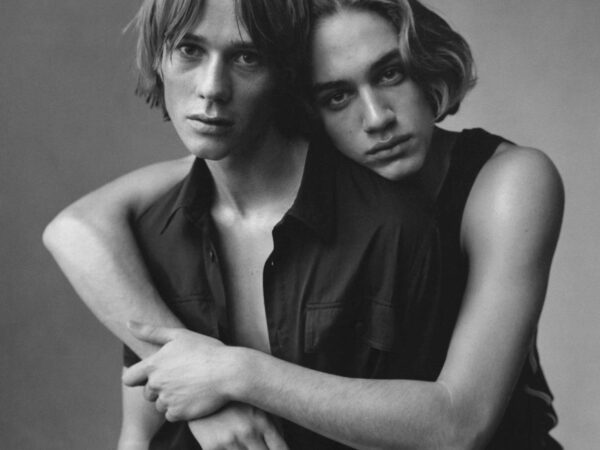Cosey Fanni Tutti's controversial 'Magazine Actions' arrives in New York with a silver frame but the same provocative questions
When the original COUM Transmissions exhibition Prostitution opened at the ICA London in 1976, the artists were famously decried by Conservative MP Nicholas Fairbairn as “wreckers of civilization.” A performance art group co-founded by Genesis P-Orridge and Cosey Fanni Tutti, COUM Transmissions’ pornography, milk enemas, and bloody tampons provoked a flurry of tabloid coverage, each new article added to the exhibition as they were published. Now, nearly 5 decades later, Fanni Tutti’s Magazine Actions at Maxwell Graham, her first US solo exhibition, arrives with much less controversy, remounting her pornographic assemblages from the ICA London show.
The title suggests a twofold embodiment of the work on display; framed pages from the porn magazines that Fanni Tutti posed for between 1972 and 1980 act as the physical traces of the performance (action) which was the modeling itself. Each work contains a single spread. To move from one to another is to watch Fanni Tutti’s identity traverse all the genera of trite sexual fantasy: here she is a housewife harboring lesbian fantasies, there a fashion model with a proclivity for knee socks. Unlike many artists then and now, she is not merely utilizing the conventions of pornography in a fine art context but inserting herself in one end of a machine and extracting it from out the other, buying her own magazines from newsstands the way anyone else would.
Fanni Tutti’s engagement with porn as a medium is refreshingly straightforward—absent both Dworkin-esque Second Wave moralizing and the false self-empowerment rhetoric typified by Onlyfans millionaires who characterize our hyper-capitalist present. In a time when nearly every sex symbol of the past forty years has come forth to reclaim their image through glossy, self-produced documentaries, Fanni Tutti’s works stand out as an act of relinquishment. She surrenders to the mechanisms of the porn industry, only retrieving her image as material once it has become publicly consumable. Its temporality stands in stark contrast to image-making as we know it today, instantaneous and under the illusion of self-control.
Stripped of COUM’s more outlandish provocations, the works take on a certain innocuousness. Frozen as these actions are into the preservation tank of sleek contemporary display (silver frames and wide mounting), the “sheer excess of pornographic spectacle” of the original 1976 show gives way to a quainter historical lens. Yet this exchange comes at a cost. The corner vitrine displaying some of the magazines veers close to providing an archival distance that is as neutralizing as it is contextualizing. Though the press release rightly asserts that Fanni Tutti be mentioned alongside more canonized performance artists like Carolee Schneeman and Vito Aconci, an overtly scholarly approach places the works in contention with the natural erosion of social and sexual mores, such that a casual encounter with them risks a certain kind of cultural nostalgia.
The articles themselves, if one takes the time to read them, harken back to the Masters and Johnson era when every facet of human sexuality, from masturbatory habits to same-sex fantasies to group sex, was the subject of sociological studies. This form of scientific legitimization, like interviews with Gore Vidal or Henry Kissinger in Playboy, sought to assuage guilt through a veneer of sophistication. In Tutti’s Joy of Female Masturbation (1977), an article bemoaning the lack of scientific research on exposure to pornography is bracketed on either side by another declaring that “masturbation is now coming into its own” while above, the artist fingers herself in a series of anatomical close-ups as if posing for a how-to manual.
There is a novelty and precarity to the conception of sexual expression now taken for granted; what was once just porn gains the vintage qualifier that blunts some of the sharper edges of sexuality. The transgression that prompted Fairbairn to call for an immediate end to public art funding in the UK feels remote, not only due to the exhibition’s historicizing framework but because of our radically transformed relationship to pornography, both in terms of its cultural acceptance and its means of production. The ideology underpinning the Trump administration’s current NEA purge stems less from the posturing of a Moral Majority than that of a conception of government withdrawn from the sphere of the public good entirely, an unbridled free market capitalism for whom pornography is closer to its avatar than its subversive foil.
As is often the case, however, there is a gap between the press release and the exhibition on display. If there is a conceptual tension between art and artifact, between medium and message, then the works themselves offer a release in their formal clarity. A historicizing view may well call for us to rethink the pantheon of conceptual performance art and to draw frightening parallels to the present political moment. It may evoke a tendency, at first glance, to gawp at the antiquated sensibilities on display here, much the way all pornography is designed to titillate first and depress after. But as with the production of the works themselves, time is what rewards, what de- and then re-eroticizes the images, not as a seduction, but in the true sense of the erotic—that is, the sublimation of the self.
Magazine Actions is on view at Maxwell Graham gallery until June 28, 2025.






















